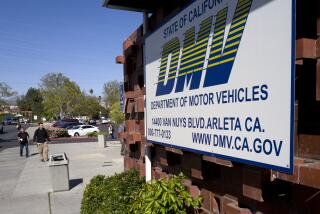The Struggle Against Drunk Drivers : New technology--and continued determination--to save lives in California
A Van Nuys resident has become the first person in Los Angeles sentenced under a new state law requiring twice-convicted drunk drivers to equip their vehicles with a device that disables it if they have a blood alcohol level higher than 0.02% (far below the legal limit). If he decides to drive his car when drunk, he will find it much harder to again endanger lives. And that could prove a godsend.
The “ignition interlock device” uses a breath analysis machine, and the driver is given a unique code and is trained to blow into the device in a particular pattern. That’s supposed to prevent the driver from employing a confederate when he gets behind the wheel. The device even demands random breath analyses during driving. If the driver has been swilling while on the road, the car’s horn will blare and the headlights will flash, alerting other motorists.
Ways can be found around this; perhaps the drunk driver will obtain another, unprotected vehicle. But the new law represents one useful weapon against a scourge that accounts for 25,000 deaths each year nationwide. Unfortunately, the law is also a tacit admission that existing statutes haven’t solved the problem. There is already a law that suspends the license of anyone caught driving drunk a second time, but even the acting supervisor of the city attorney’s office admits that many “persons who have been ordered not to drive will drive anyway.”
The good news is that the California Highway Patrol’s most recent statistics show a continuing decline in alcohol-related driving fatalities and injuries, with the largest decreases occurring in Orange and Ventura counties. Among the reasons cited for the improvement is a 1990 law that allows police to conduct on-the-spot driver’s license suspensions of any motorist arrested on suspicion of driving under the influence.
The bad news is that drunk drivers are continually finding ways to skirt existing laws. By one estimate, for example, three out of every 100 drivers on the road are repeat offenders under drunk-driving laws. Think about that the next time you’re on the entrance ramp of your favorite freeway, watching the traffic rush by.
More to Read
Sign up for Essential California
The most important California stories and recommendations in your inbox every morning.
You may occasionally receive promotional content from the Los Angeles Times.










